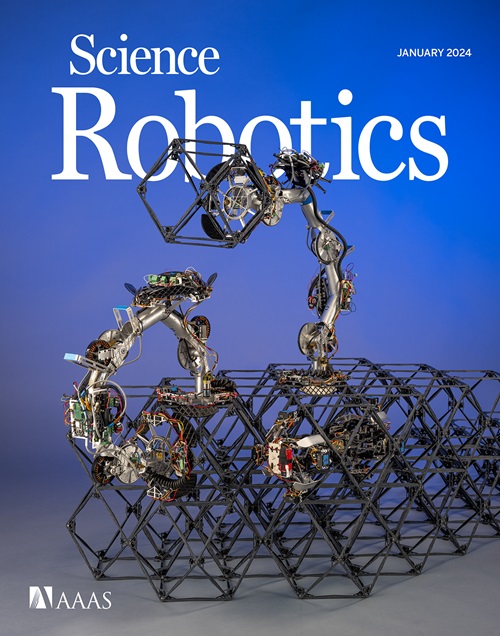Soft robotic artificial left ventricle simulator capable of reproducing myocardial biomechanics
IF 26.1
1区 计算机科学
Q1 ROBOTICS
引用次数: 0
Abstract
The heart’s intricate myocardial architecture has been called the Gordian knot of anatomy, an impossible tangle of intricate muscle fibers. This complexity dictates equally complex cardiac motions that are difficult to mimic in physical systems. If these motions could be generated by a robotic system, then cardiac device testing, cardiovascular disease studies, and surgical procedure training could reduce their reliance on animal models, saving time, costs, and lives. This work introduces a bioinspired soft robotic left ventricle simulator capable of reproducing the minutiae of cardiac motion while providing physiological pressures. This device uses thin-filament artificial muscles to mimic the multilayered myocardial architecture. To demonstrate the device’s ability to follow the cardiac motions observed in the literature, we used canine myocardial strain data as input signals that were subsequently applied to each artificial myocardial layer. The device’s ability to reproduce physiological volume and pressure under healthy and heart failure conditions, as well as effective simulation of a cardiac support device, were experimentally demonstrated in a left-sided mock circulation loop. This work also has the potential to deliver faithful simulated cardiac motion for preclinical device and surgical procedure testing, with the potential to simulate patient-specific myocardial architecture and motion.
能够再现心肌生物力学的软机器人人工左心室模拟器
心脏错综复杂的心肌结构被称为解剖学上的 "戈尔迪之结",由错综复杂的肌肉纤维纠结而成。这种复杂性决定了同样复杂的心脏运动在物理系统中难以模仿。如果这些动作可以由机器人系统生成,那么心脏设备测试、心血管疾病研究和外科手术训练就可以减少对动物模型的依赖,从而节省时间、成本和生命。这项研究介绍了一种受生物启发的软机器人左心室模拟器,它能够再现心脏运动的细节,同时提供生理压力。该设备使用细丝人工肌肉来模拟多层心肌结构。为了证明该装置能够跟踪文献中观察到的心脏运动,我们使用犬心肌应变数据作为输入信号,随后将其应用于每个人造心肌层。在左侧模拟循环回路中,我们通过实验证明了该装置在健康和心力衰竭条件下再现生理容积和压力的能力,以及有效模拟心脏支持装置的能力。这项工作还有可能为临床前设备和外科手术测试提供忠实的模拟心脏运动,并有可能模拟患者特定的心肌结构和运动。
本文章由计算机程序翻译,如有差异,请以英文原文为准。
求助全文
约1分钟内获得全文
求助全文
来源期刊

Science Robotics
Mathematics-Control and Optimization
CiteScore
30.60
自引率
2.80%
发文量
83
期刊介绍:
Science Robotics publishes original, peer-reviewed, science- or engineering-based research articles that advance the field of robotics. The journal also features editor-commissioned Reviews. An international team of academic editors holds Science Robotics articles to the same high-quality standard that is the hallmark of the Science family of journals.
Sub-topics include: actuators, advanced materials, artificial Intelligence, autonomous vehicles, bio-inspired design, exoskeletons, fabrication, field robotics, human-robot interaction, humanoids, industrial robotics, kinematics, machine learning, material science, medical technology, motion planning and control, micro- and nano-robotics, multi-robot control, sensors, service robotics, social and ethical issues, soft robotics, and space, planetary and undersea exploration.
 求助内容:
求助内容: 应助结果提醒方式:
应助结果提醒方式:


